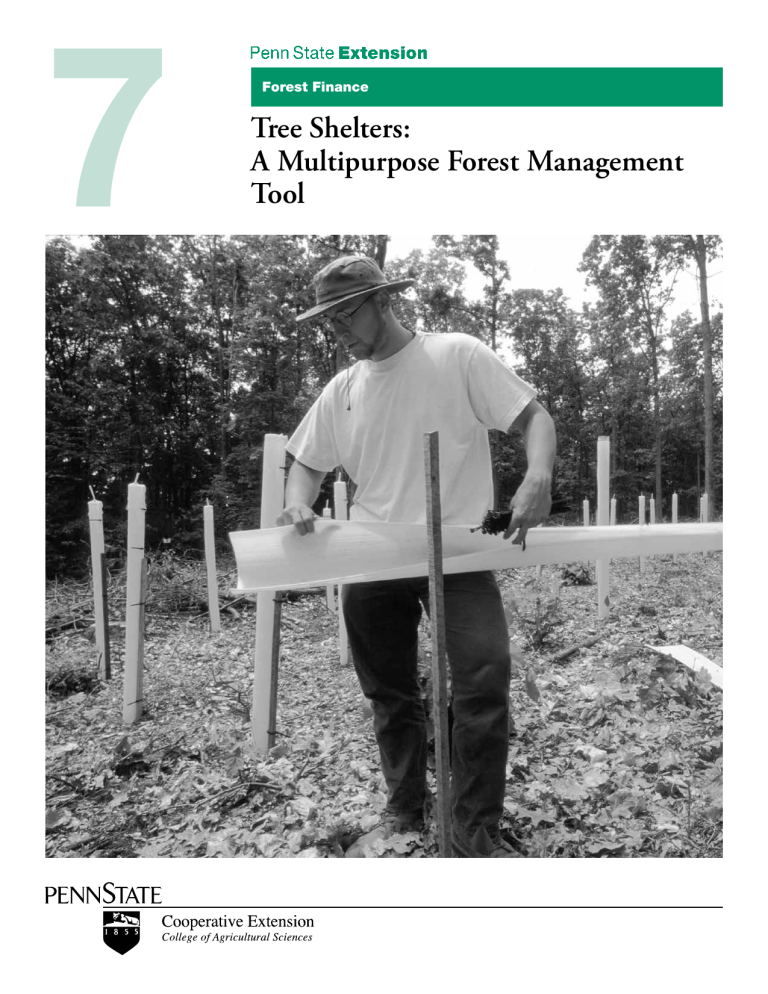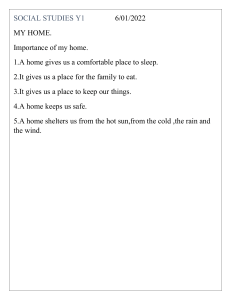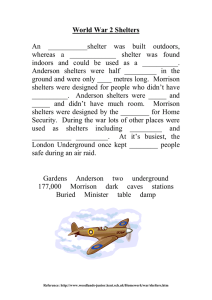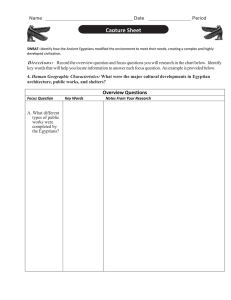
7 Forest Finance Tree Shelters: A Multipurpose Forest Management Tool Introduction “Tree shelter” is a generic name for a solid (or mesh) tube that is placed over a seedling to provide favorable environmental conditions for seedling growth. During the early 1980s, tree shelters were introduced in Pennsylvania primarily to improve the survival and growth of newly planted trees. Tree shelters were originally designed to create a “greenhouse”-type environment by increasing air temperature, humidity, and carbon dioxide levels. At first, shelters received much attention and were heavily used, but recent usage has slowed due to the forestry community’s concerns about expense and success. Over the years, tree shelters have been redesigned a number of times. Results differ as new shelters arrive on the market. The reported benefits of tree shelters include reduced stresses on seedling growth and protection from animal damage. Government agencies, private forest landowners, and farmers in Pennsylvania use tree shelters to establish trees on old field sites, along streams, and in natural forests. Much of the research on shelters in Pennsylvania focuses on the highly valuable commercial timber species such as northern red oak (Quercus rubra) and black walnut (Juglans nigra). Using shelters around these and other valuable hardwoods in old fields mimics natural regeneration under shade by lowering light intensities, increasing humidity, and reducing air movement. Reforesting riparian areas is extremely important for restoring water quality and providing other economic and environmental benefits. Shelters are also used on extreme sites (e.g., reclaimed surface mines) and areas where seed sources are absent. Due to the heavy deer browse in many parts of Pennsylvania, some form of seedling protection is almost a necessity. Other tools to protect seedlings include repellents and fences. Repellents are not reliable, except in small areas and over short periods of time. Cost of repellent materials and labor for repeated applications are often prohibitively high. Deer fencing, discussed in Forest Finance 2, is an economical alternative in many situations, especially for larger regeneration areas. Tree shelters play an important role in many situations. this publication discusses uses, types, and costs of tree shelters. Pros and Cons of Tree Shelters Early Growth Many studies indicate that in the early stages of development shelters produce seedlings with longer stems and fewer branches, but they are smaller in diameter compared to unsheltered seedlings. The shade acclimation and light reduction— along with less wind and fewer mechanical stresses—allow sheltered seedlings to concentrate most of their energy on height growth, not on roots or stem diameter. Research has shown that sheltered seedlings’ height growth was almost twice that of unsheltered seedlings in the early growing years. Height growth will reportedly slow if the shelter is not well sealed to the ground. 2 Post-shelter Stability and Growth Often seedlings are not able to stand upright as they come out of the unvented shelters. Some research indicates that vented shelters show the same diameter growth as unsheltered seedlings. Furthermore, research indicates that unsheltered trees do as well as sheltered seedlings a few years after emerging from the shelter. For eastern hardwoods, the seedlings usually take about two to three growing seasons to emerge from the shelter, but need an additional 2 to 4 years’ support to enable the trees to strengthen and support themselves. Fast-growing trees may require early shelter removal. Alternatively, some shelters have slits that can be opened so that the shelters may be left in place after seedlings emerge. Most manufacturers recommend leaving the shelter in place until the tree reaches the diameter of the tube. Once out of the shelter, some species adapt well to differing environmental and competing vegetation conditions and can develop into forest-grown trees. Widely spaced trees may develop heavily branched crowns rather than vertically growing stems characteristic of commercial timber trees. Deer Most foresters use tree shelters to protect against deer browse. Tree shelters, if tall enough, are usually successful at protecting seedlings from deer and other mammalian browse. A 4-foot shelter is most common and is said to prevent most deer browsing. However, 5-foot shelters are recommended in deep snow or in areas with severe deer browse. In addition, deer may eat undesirable seedlings that are present in the understory, reducing weeds (competition for the protected seedlings) and possibly costs associated with the need to spray unwanted vegetation. Bucks may rub against shelters; there- fore shelters need to be securely staked to the ground. In addition, shelters will protect seedlings from bucks rubbing their antlers on newly established trees. Rodents If well secured to the ground, shelters can prevent small animals such as rabbits, voles, and mice from girdling the seedlings. However, shelters are also known to harbor rodents that seek protection from predators. Thick vegetation around shelters provides excellent rodent habitat. Research has shown that lighter and brighter shelters have less vole damage than dark ones. To minimize rodent damage, install the shelter snugly to the ground but not in the ground. Check the inside of shelters periodically for damage or rodent nests. Remove any nests that you find. Bait such as a rodenticide placed inside or around the shelter at regular spacing can be used as a control. Birds and Insects Birds, especially songbirds, are a nuisance because they perch on the shelters and can damage emerging shoots and inhibit terminal growth of the trees as the shoots reach the tops of the shelters. Mesh netting placed over the shelters prevents birds from falling into the shelters and dying. Netting also reduces wasp and bee nests as well as damage from Japanese beetles. Bears may destroy tree shelters while in search of bee nests in the shelters. Removing the netting is important as the terminal leader emerges to prevent it from getting snagged and deforming the stem. Competing Vegetation Temperature Using tree shelters may not eliminate the need to control competing vegetation. Weeds in shelters are generally not a major problem, but weeds and grasses surrounding shelters have been shown to decrease seedling growth and reduce the shelters’ effectiveness. Roots of sheltered trees are smaller in comparison to its stem (smaller root-to-shoot ratio than normal trees) and therefore need to fight harder with competing vegetation for water and nutrients. Competing vegetation is often more adapted to a site and is more vigorous and aggressive than the desired seedling. If competing vegetation control is necessary, shelters will help protect the seedlings from herbicide application. The high temperatures reached in shelters can rise above the optimal growth range of some species. Although touted to provide greenhouse conditions, some research has shown that ventilation or use of mesh shelters causes less mortality by allowing heat and humidity to dissipate. Ventilated shelters, on the other hand, reduce the greenhouse effect—the beneficial microclimate— and may make seedlings more favorable to insect attack. Wet and humid conditions due to higher temperatures have also been shown to cause mold in unvented shelters. Wind Wind protection provides reduced transpiration by increasing the relative humidity inside the shelters. Although important to facilitating seedling growth, wind can knock over shelters, killing the trees. Stake and support placement is important­—shelters begin to lean if not well secured. Tree shelters must be inspected periodically to ensure that they are straight and secure. Plastic Waste Many shelter manufacturers claim that their products photodegrade. Regardless of how long the shelters last, when their job is done, they will not simply disappear. They either will remain, sometimes damaging the tree, or they will fall to the ground. They often break into pieces and, after a few years, can cause quite a litter problem. The type of shelter used affects ease of removal and cleanup. 3 Unvented shelters have been known to cause dieback or mortality due to higher maximum temperatures and lower minimum temperatures (in winter). This has been attributed to insufficient “hardening off” of the seedling. Some shelters are designed to slide off or open to reduce this problem. Shelters may also cause seedlings to break bud earlier in the spring, making them susceptible to late frosts. Natural Regeneration In order to protect natural regeneration, judiciously select potential “crop” tree seedlings that look healthy and place shelters over them. Tree shelters can also be placed over stump sprouts in harvested stands. Shelters’ best results come in full- or near-full-sunlight conditions. Light levels are critical since shaded seedlings grow slower and often fail to survive in partial cuttings. Sheltering natural seedlings eliminates the cost of planting and protects the seedling from white-tailed deer. Shelter seedlings in natural regeneration after removing the overstory and prior to spring bud break. Tree shelters come in many shapes, sizes, and colors. The following discusses the range and types of shelters to help determine which ones serve the best purposes. Traditional shelters are made of translucent, twin-walled polyethylene. Most shelters are approximately 4 inches in diameter and up to 6 feet tall. Some newer shelters have special colors to reflect or absorb light, some are made of PVC pipe, and some have holes or are made of mesh or wire to provide ventilation. Shelters are generally held in place by plastic or wire ties fastened to wooden stakes. Probably the least-costly approach in terms of materials is to use construction-grade plastic sheeting with stakes and staples. The diameter of the shelter does not have a large impact on survival. Large diameters are more expensive to construct with no additional growth benefit. In fact, the shelter effect is said to decline as the diameter exceeds 4 inches. However, reports indicate that shelters less than 3.5 inches in diameter cause the leaves to bunch up approximately one-half to two-thirds of the way up the tree. As the tree produces more leaves, the shelter becomes more crowded, which may lead to mold problems. Eventually the tree may stop producing leaves, affecting growth and stem formation. However, little research supports long-term damage to the trees. Some shelter producers allow the diameter to expand by attaching a second or third protector using lock ties. One manufacturer produces a conical shelter, which goes from 8 inches at the bottom to 4 inches at the top. Shape Strength and Durability Things to Consider When Purchasing Tree Shelters The shape of the shelter whether round, square, triangular, or hexagonal does not appear to have any significant effect on seedling growth. The only problem with nonround, folded shelters is that they may split. Also, the tops of some shelters are modified— bent outward (flared) at the top—to help reduce stem abrasion. Size There is a tradeoff between tree shelter height, cost, and release time. If deer browse is extensive, the shelter will need to be taller to afford the tree more protection for a longer period of time, thus resulting in a higher cost. To determine the optimal height, consider potential browse impact and costs. Although 4 feet is the most common size, shorter shelters are effective enough to provide growth enhancement, if deer are not a problem. More research is needed in this area. Climatic conditions and environmental factors affect a shelter’s longevity. The ideal shelter provides microenvironmental needs and support and finally disintegrates without cost for removal. Polyethylene, the most common material used, is strong and not toxic when it decomposes. Ultraviolet light inhibitors are added to delay photodegradation of polyethylene for approximately 5 to 8 years. Another material used is solid PVC pipe, which does not degrade quickly. Some shelters have dual walls and are corrugated to add strength and rigidity. The more rigid, however, the better the chance for stem abrasion, which may result in stem deformations. The durability and sturdiness of stakes are also important. Iron, fiberglass, plastic, or treated wood stakes are the sturdiest. Make sure the stakes are well secured to tree shelters—about 1 foot deep in the ground and extend at least two-thirds of the shelter’s height. 4 Color Color is discussed often but is not a big concern, especially on sites that receive at least 6 hours of sunlight a day. Try to plant seedlings in full sunlight to maximize the greenhouse effect in the shelters. The thinking behind colored shelters is to mimic nature, which implies a color between clear and dark. In shaded areas such as shelterwood harvests, it has been shown that seedlings in shelters grow at lower rates than in open areas, no matter what the color. However, studies show that sheltered oak growth is best when chlorophyll absorption is greatest, implying that nongreen wavelengths are best. Most modern shelters are light-brownish pink to provide this effect. White or clear shelters allow the most light and are shown in some studies to produce the greatest height growth. Brown shelters, in the same study, were shown to reduce photosynthesis and growth. Cost Due to the relatively high cost of shelters, the first rule is to use only the minimum number needed. Depending on the management objective, this can range from fewer than 50 to up to 400 shelters per acre. If the site is a mixed planting, use shelters on the high-value species, those that are difficult to establish, or those that are highly preferred by deer. Often the landowner may plan to plant more trees per acre but only shelter half of them as insurance. The second rule is that the higher the deer impact, the fewer the plants per acre and the more those plants need sheltered protection. costs associated with using shelters include material and labor. Labor is a variable cost dependent on whether you use a contractor or do the work yourself. In addition, seedling, site preparation, and planting costs are obviously important to consider, although not discussed in this publication. Prices of shelters vary by manufacturer and quantity purchased. the costs of shelters from three vendors in 2004 for 4- and 5-foot-high shelters ranged from $1.20 to $3.75 each when a minimum of 50 shelters were purchased. Prices decrease as the quantity increases. Stakes generally cost about $1.00 each. Table 1 shows the cost differentials by quantity used and acres planted. In the example, the cost per shelter including the stake is $3.00. Buying shelters in quantity, however, reduces prices. In this example, prices are reduced 10 percent ($2.70) for purchasing 200 or more and 15 percent ($2.55) for more than 400. Pooling resources and purchasing shelters in bulk can be cost effective for landowners. When does it pay to use fencing instead of shelters if deer are the primary concern? You can estimate that deer fencing in Pennsylvania—albeit the price decreases as acreage increases—is about $300 to $400 per acre, inclusive of installation costs (see Forest Finance 2). Note that the table of tree shelter prices does not include installation costs. Both fencing and shelters require periodic maintenance. The table shows that sheltering more than 100 seedlings per acre generally makes fencing more economical, but fencing generally does not become economical until many acres are involved. For smaller acreages or if the plantings are not adjacent to each other, trees shelters may be more cost effective than fencing. Along riparian areas or where narrow strips are planted, fencing is less cost effective. Table 1. Tree shelter prices. 50 tree shelters/acre 100 tree shelters/acre 200 tree shelters/acre 400 trees shelters/acre Acres planted 1 $150 $300 $540 $1,020 5 $750 $1,500 $2,700 $5,100 10 $1,500 $3,000 $5,400 $10,200 You also need to consider installation and maintenance costs. Labor costs include time to install the tree shelters and place them over the seedlings. Some shelters come ready to use, others need to be assembled. Generally, shelters are shipped flat to save on mailing costs. Pre-assembled shelters require little on-site assembly and speed up installation. Be sure to read and follow manufacturers’ recommendations. Once the shelters are in place, maintenance costs include weeding around the shelters, straightening leaning shelters, and checking for insects, diseases, dieback, and animal damage. When maintaining, look inside shelters, check for shelters and stakes that need replacing, and remove netting when seedlings reach the tops of the shelters. Reusing tree shelters and stakes can reduce the cost. Nondegradable shelters and durable stakes can be reused. The cost of tree shelters can be viewed as an opportunity cost of not having the seedling survive. Without the shelter, you may need to replace and replant new seedlings. Repeated failure and replanting can often exceed the cost of the tree shelters. The financial benefit of tree shelters is the opportunity cost of not using the protection. In addition to replanting costs, this benefit includes the value of knowing a future forest is regenerating or that water quality and riparian habitat are protected. Looking strictly at financial rates of return, you can argue that tree shelters are not a great investment. 5 For example, compounding the present value of the tree shelters at a 4 percent interest rate shows that in 80 years the return on using 100 shelters per acre ($300) needs to bring about $7,000 per acre in revenue at harvest. Many mature forests in Pennsylvania currently do not provide that amount of revenue per acre from a timber harvest, but future stumpage prices are not predictable. Selecting valuable species can make the investment more effective. Interplanting crops, herbs, fruits, nuts, or other products can provide income while the trees are growing. Some government programs provide financial assistance for tree planting. For example, up to $10,000 per year of reforestation costs can be deducted from federal income tax. Some federal cost-share programs such as the Conservation Reserve Enhancement Program (CREP) and the Environmental Quality Incentive Program (EQIP) provide cost-share funding for shelters that provide environmental services such as riparian buffers. Sources of Tree Shelters A variety of shelters are on the market. Only a few manufacturers, however, make them in lengths over 4 feet. As mentioned, most cost effective—but also most labor intensive—is using plastic construction sheets. This market is ever changing with new suppliers coming in and old ones leaving. New innovations and shelter designs are continually introduced. The following suppliers are currently found on the Internet and are available for use in Pennsylvania. You should examine the different type of shelters each vendor provides and discuss situations with other landowners and natural resource professionals before deciding. Blue-X Tree Shelter The Blue-X shelters are made of rolled, recycled X-ray film inserted in a poly sleeve. The inner, blue, plastic film can be stored for reuse. A replacement sleeve can be purchased separately in order to reuse the plastic film. McKnew Enterprises PO Box 2128 Elk Grove, CA 95759 Phone: 888-472-5839 Fax: 916-683-4780 Email: tubemaster@growtube.com Website: www.growtube.com/shelters .html Protex Pro/Gro Tube Tree Pro Tree Protector Protex tree protectors consist of flat, plastic sheets. The sheets are rolled into a cylinder to create a tube. Tree Pro tree protectors are flat, polyethylene sheets that are formed into tubes using lock ties when placed around the trees. Terra Tech, LLC PO Box 2128 Eugene, OR 97405 Phone: 800-321-1037 Fax: 800-933-4569 Email: customerservice@terratech.net Website: www.terratech.net Tree Sentry Tree Sentry tree shelters are 18 inches high and made of a photodegradable polymer. They have a unique, tapered, conical shape and come completely assembled including integral stakes. Optional mesh tube extends browse protection to 4 feet. Summit Environmental Group, LLC PO Box 12267 4500 N. Detroit Ave. Toledo, OH 43612 419-720-0185 Fax: 419-720-0187 Email: sales@summitenvironmental .net Website: www.summitenvironmental .net 6 Miracle Tube Tree Shelter Miracle Tube tree shelters are polyethylene tubes. Miracle Tube can be supplied in either vented or unvented styles. Tree Pro 3180 West 250 North West Lafayette, IN 47906 Phone: 800-875-8071 Fax: 765-463-3157 Email: sales@treepro.com Website: www.treepro.com Tubex Tree shelter The Tubex trees shelter is made from a chemically nonreactive and biologically inert polypropylene. It consists of a seamless, twin-walled, solid, translucent tube. The top rim of the tube is flared to protect the seedling. Treessentials Company 60 E Plato Boulevard Suite 130 Saint Paul, MN 55107-1827 Phone: 800-248-8239 Fax: 651-681-1951 Email: ksturgeleski@treessentials.com Website: www.treessentials.com Conclusion Throughout their brief history, tree shelters have proven to significantly increase seedling survival rates. The growth-enhancement benefits provided by the mini-greenhouse environment was the initial selling point of shelters. A number of concerns emerged to highlight caution of wholesale shelter use. Concerns include shelter stability and durability, seedling stability after emerging from the shelter, and protection from insects, diseases, birds, and rodents that may damage or kill the sheltered seedling. Today, however, shelters are used more for protection from deer browse and other nuisance wildlife. Enhanced growth and survival have become secondary benefits. Shelters are expensive and their use must correspond to management objectives. Other options such as fencing are available to control deer damage. Shelters can be economical, depending on acres planted and number of shelters used per acre. The benefits of tree shelters help ensure that regeneration objectives are achieved. Through the use of tree shelters, species diversity can be broadened, wood products can be grown, and a future food supply for wildlife, such as acorns for deer and turkey, can be assured. Protecting valuable species is important and, if conditions warrant, trees shelters play an important role in assisting foresters and landowners to achieve their land management objectives. Not enough research has been conducted about the impacts of shelters on long-term growth, but they clearly play a role in preventing browse damage. Research also continues on the interactions and effects of shelters with other established silvicultural practices such as competing vegetation control and fertilization. Many different shelters are available on the market. Vendors tout different benefits in terms of color, durability, shape, and ventilation. No clear consensus as to the preferred type of shelter is available. However, since the early days of shelters when most were dark, brown, and unvented, a shift toward a new generation of lighter-colored and vented shelters has occurred, in part due to the combined effect on rodent damage, dieback, heat stress, and growth. In many cases, site-specific conditions and expected benefits from a shelter affect the choice of shelter. Whichever type of shelter used, it must be monitored and maintained. Without adequate maintenance, you can expect a relatively high failure rate. 7 Prepared by Mike Jacobson, assistant professor of forest resources, and Dave Jackson, forest resources extension educator. Penn State College of Agricultural Sciences research and extension programs are funded in part by Pennsylvania counties, the Commonwealth of Pennsylvania, and the U.S. Department of Agriculture. Where trade names appear, no discrimination is intended, and no endorsement by Penn State Extension is implied. This publication is available in alternative media on request. Penn State is an equal opportunity, affirmative action employer, and is committed to providing employment opportunities to minorities, women, veterans, individuals with disabilities, and other protected groups. Nondiscrimination: http://guru.psu.edu/ policies/AD85.html Produced by Ag Communications and Marketing © The Pennsylvania State University 2004 Code UH169 5/14pod






